Sintra is a delightful Portuguese town, close to Lisbon, that has an abundance of wonderful tourist attractions. Known for its romanticism and architecture, there’s a range variety of ancient castles and sumptuous palaces. A true journey to times of kings and queens with enigmatic constructions!
Pena National Palace (Palácio da Pena)
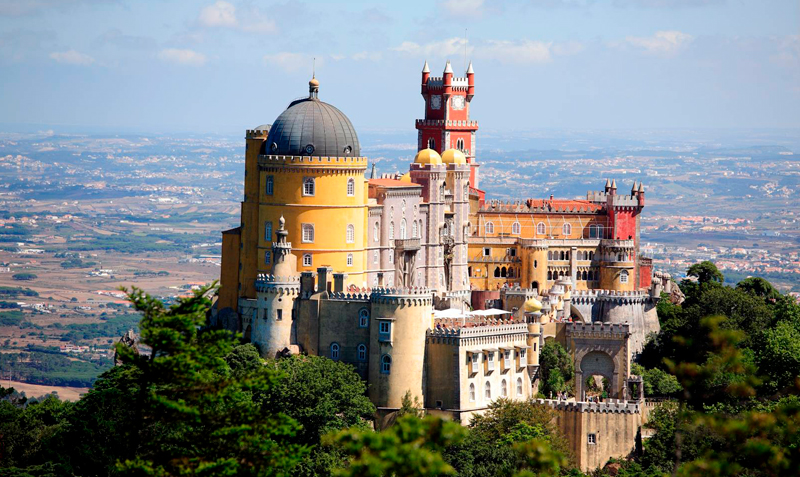
The palace is the second highest point of the hill. Built in a way to be visible from any point of the park . The Park and Palace of Pena are the result of King Fernando II’s creative genius and the truly expression of 19th-century romanticism in Portugal, denoting clear influences from the Manueline and Moorish styles of architecture.
In 1838, King Fernando II acquired the former monastery of Our Lady of Pena. Built in 1511, the Palace was left unoccupied since 1834, when the religious orders were suppressed in Portugal.
In roughly 1843, the king decided to enlarge the palace by building a new wing (the New Palace) with even larger rooms (like the Great Hall), ending in a circular tower next to the new kitchens.
The Park planted surrounding the Palace created a luxuriant garden with over five hundred different species of trees and plants originating from all over the world. Some of them no longer exist in the countries and continents from which they originate.
This park offers wonderful walks, with numerous things to discover. There are bridges and grottoes, picturesque ponds, garden seats, sculptures, pergolas and fountains.
The Palace of Pena was designated a National Monument in 1910 and it is part of the Cultural Landscape of Sintra, which has been classified by UNESCO as World Heritage since 1995. Sintra was the first to receive this category in Europe.
Since 2007, it is one of the seven wonders of Portugal and integrated the Network of European Royal Residences in 2013.
Opening Times 2018/2019
PARK
09:30 – 20:00, last ticket and last admission 19:00
PALACE
09:30 – 19:00, last ticket 18:15 and last admission 18:30
Prices 2018/2019
PALACE AND PARK Tickets
Adults (18 – 64 yrs) – 14 euros
Youths (6 – 17 yrs) – 12,5 euros
Seniors (over 65 yrs) – 12,5 euros
Family ticket (2 adults + 2 youths) – 49€
PARK Tickets
Adults (18 – 64 yrs) – 7,5 euros
Youths (6 – 17 yrs) – 6,5 euros
Seniors (over 65 yrs) – 6,5 euros
Family ticket (2 adults + 2 youths) – 26€
Entrance in the Chalet of the Countess of Edla included
Quinta da Regaleira Palace
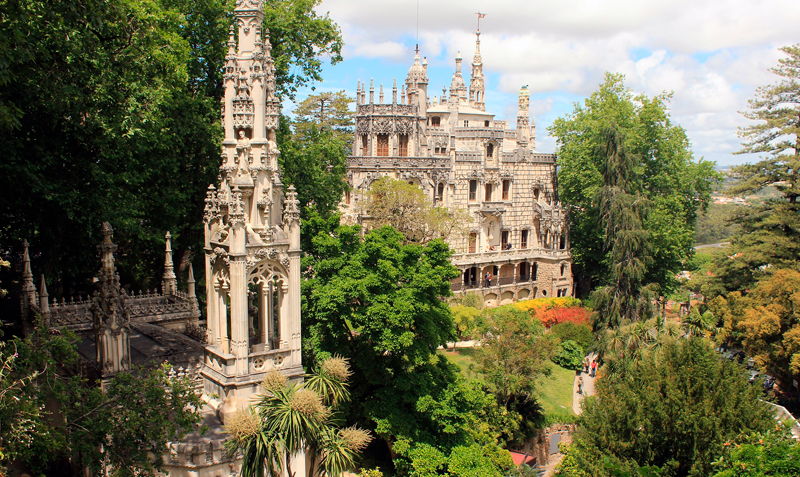
Quinta da Regaleira is one of the most surprising of all Sintra’s monuments. Built between 1904 and 1910, in the last days of the Portuguese monarchy. Situated on the mountainside near the historic centre.
The land had many owners over the years like Viscountess of Regaleira Carvalho Monteiro.
Monteiro was eager to build a place where he could collect symbols that reflected his interests and ideologies.
The 4-hectare villa is surrounded by a romantic chapel, luxurious gardens, lakes, grottoes, wells, benches and fountains. The vast array of exquisite and enigmatic constructions allegedly have symbols related to alchemy, Masonry, the Knights Templar, and the Rosicrucians. The architecture Manini designed evoked Roman, Gothic, Renaissance, and Manueline styles
The estate was later sold to Waldemar d’Orey, who used it as private residence for his extensive family. Japanese Aoki Corporation bought the palace in 1987. The corporation kept it closed to the public for ten years, until it was acquired by the Sintra Town Council in 1997.
Extensive restoration efforts were promptly initiated throughout the estate. It finally opened to the public in June 1998 and began hosting cultural events. In August of that same year, the Portuguese Ministry of Culture classified the estate as “public interest property”.
The palace contains five floors (a ground floor, three upper floors, and a basement).
The Regaleira Chapel is Roman Catholic and stands in front of the palace’s main façade. The interior is richly decorated with frescoes, stained glass windows and lavish stuccoes.
The tunnels
The park also contains an extensive and enigmatic system of tunnels, which have multiple entry points that include: grottoes, the chapel, Waterfall Lake, and “Leda’s Cave,” which lies beneath the Regaleira Tower.
Inverted Towers
The inverted towers or Initiation Wells are two wells on the property that resemble underground towers lined with stairs. These wells never served as water sources. Instead, they were used for ceremonial purposes that included Tarot initiation rites. The tunnels connect these wells to one another, in addition to various caves and other monuments located around the park. Of the two wells, the larger one contains a 27-meter spiral staircase with several small landings.
Lakes, Fountains and the Aquarium
There are several water spots in the park. Monteiro added two artificial lakes and fountains. One of the most interesting and extravagant among them is the Aquarium. It was once considered the most important naturalist property in Regaleira. However, the Aquarium is no longer used.
Opening Times 2019
1st April until 30th September
Opening 09:30 AM
Last entrance 07:00 PM
Closing 08:00 PM
1st October until a 31th March
Opening 09:30 AM
Last entrance 05:00 PM
Closing 06:00 PM
Tickets 2019
Child (up to 5 years old) Free
Young (6 – 17 years old) 5€
Adult (18 – 64 years old) 8€
Senior (65 – 79 years old) 5€
Senior + (from age 80) Free
Family – 2 Adults/Seniors + 4 Young (maximum of 6 pax) 22€
Monserrate Palace (Palácio de Monserrate)
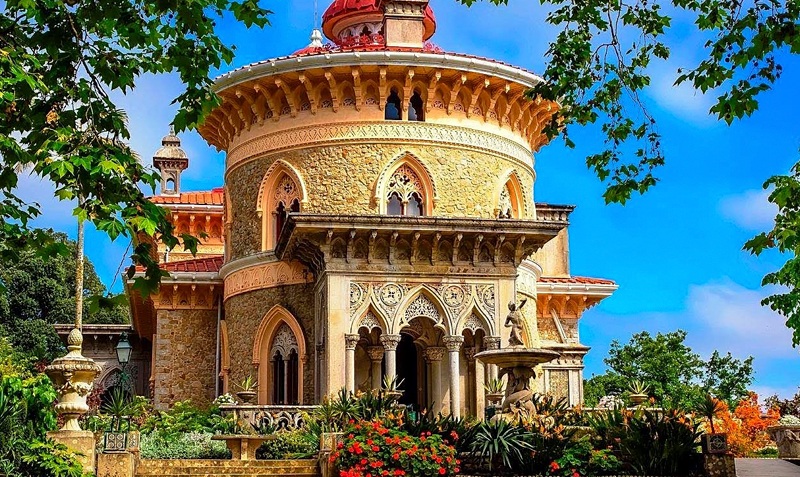
Not very far from the historic centre of Sintra is one of the most beautiful architectural and landscape Romantic creations in Portugal: the Park and Palace of Monserrate, unique representatives of 19th century eclecticism.
The Monserrate Palace combines gothic and Indian influences and Moorish suggestions together with exotic and plant motifs which are harmoniously extended to the exterior. The Palace is full of details, especially in the textures on the walls and ceilings.
In the Garden there is a huge botanical diversity, organized by geographical areas from all around the world. Designed in a romantic style with a lake, several springs and fountains, grottoes, and surrounded by lush greenery with rare species.
In 1789, an English merchant named Gerard de Visme rented the farm. In 1809, the property was in ruins, when Lord Byron visited. Its magnificent appearance inspired the poet, who mentioned it in Childe Harold’s Pilgrimage. After that, the property attracted foreign travellers’ attention. One of them was Francis Cook, a wealthy English merchant who subleased the estate in 1856 and later distinguished with the title of Viscount of Monserrate. Cook purchased the property in 1863 and started reconstructing on the remains of the house. The Palace became the summer residence of the Cook family.
The design was influenced by Romanticism and Mudéjar Moorish Revival architecture with Neo-Gothic elements. The Islamic architectural influence is in reference to when the region was a part of the wider Muslim Gharb Al-Andalus until the 13th century.
The property was acquired by the Portuguese state in 1949. In 1978, the Park and Palace of Monserrate were categorized as a building of public interest. Latter, in 2013, the Park of Monserrate was honored with European Garden Award.
Opening Times 2018/2019
PARK
09:30 – 20h00, last ticket and last admission 19:00
PALACE
09:30 – 19:00, last ticket 18:15 and last admission 18:30
Prices 2018/2019
PARK AND PALACE Tickets
Adults (18 – 64 yrs) – 8€
Youths (6 – 17 yrs) – 6,5€
Seniors (over 65 yrs) – 6,5€
Family ticket (2 adults + 2 youths) – 26€
Seteais Palace (Palácio de Seteais)
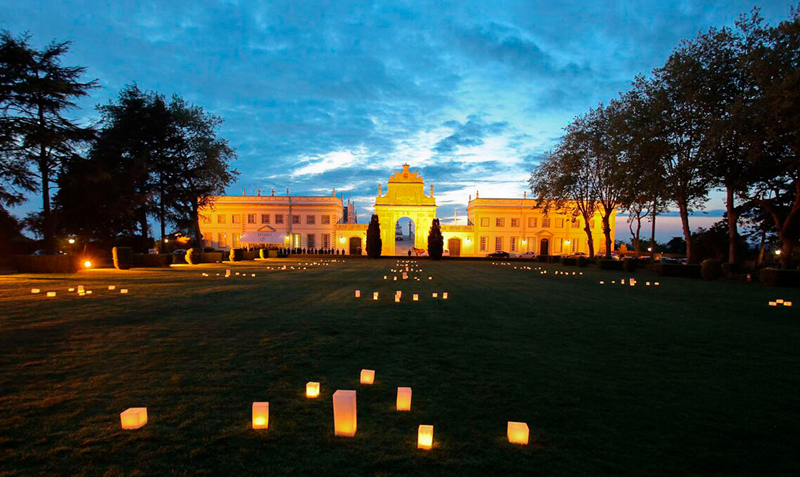
Seteais Palace is a neoclassical palace located in Sintra, operating as a luxury hotel. The palace is a national landmark and included in the UNESCO Cultural Landscape World Heritage Site listing.
Marquês de Pombal granted the lands to the Dutch consul, Daniel Gildemeester. He builted the Seteais Palace between 1783 and 1787.
The consul chose to build his house on the border of an elevation, from which he could admired Sintra’s landscape. The palace was surrounded with a large garden with fruit trees.
In 1797, some years after the consul’s death, his widow sold the palace to Diogo José Vito de Menezes Noronha Coutinho, 5th Marquis of Marialva. The neoclassical architect José da Costa e Silva was responsible for enlarging the Palace in 1801. The palace turned into a symmetrical U-shaped building, with the consul’s house becoming one of its wings. The cornice of the buildings that compose the main façade still have typical neoclassical motifs like vases, busts and reliefs of garlands. The gardens were remodelled following romantic trends.
In 1802, the Prince regent John VI and Princess Carlota Joaquina, visited the palace. In their honour a beautiful neoclassical arch was built, connecting the old and new wings.
French painter Jean Pillement and his followers decorated the walls of several inner rooms of the palace with frescos. Painted motifs include exotic vegetation and mythological characters, typical of neoclassical.
After changing hands several times, the palace was acquired by the Portuguese government in 1946. The Seteais Palace is used as a luxury hotel since 1954 and its original characteristics are still preserved.
Moorish Castle (Castelo dos Mouros)
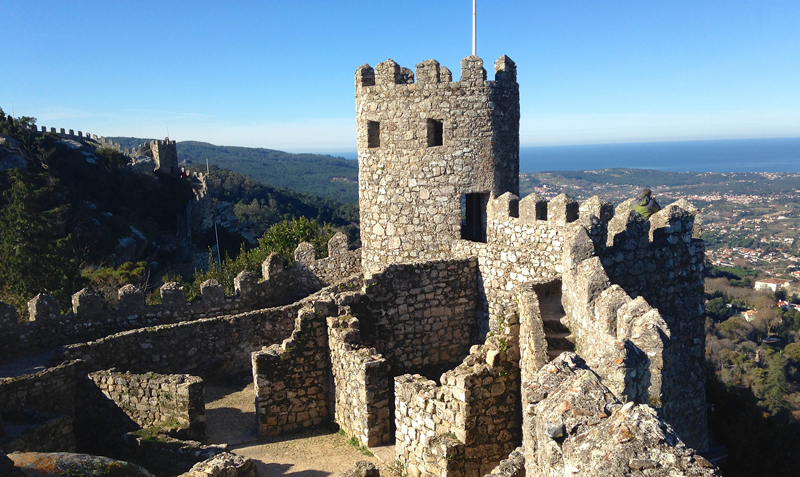
The Moorish Castle is a fortification! Built around the 10th century in one of the peaks overlooking Sintra’s Hills. It was an important strategic point during the Reconquista.
The castle was constructed during the period of Muslim Iberia. The territory was primarily agricultural and for that reason it was necessary to protect its population.
Its place on the hilltop, surrounded by and including the natural and exotic vegetation, accentuates the Romantic character of the place.
The current configuration of the Moorish Castle derives from a series of building campaigns and interventions taking place during the first dynasty, by Afonso Henriques; through to the utilisation of the fortification during the reign of Fernando I (1383); the damage caused by the 1755 earthquake; the restoration work undertaken by Fernando II in the 19th century within the Romantic tastes of that time and as well as the interventions carried out by the General Directorate of National Buildings and Monuments in the 20th century.
In order to support the restoration and deepen the historical knowledge, the project was accompanied by archaeological excavation works, ongoing since 2009. These archaeological works enabled a full understanding of the occupation of this site over the centuries: identification of a medieval Christian cemetery, silos and the foundations to Moorish residences along with objects and artefacts from the Bronze Age, from the Iron Age and the Neolithic period, including the singular highlight of a complete ceramic vase dated to the 5th century BC.
The Moorish Castle was classified as a National Monument in 1910 and forms part of the Sintra Cultural Landscape classified by UNESCO as World Heritage since 1995.
Opening Times 2018/2019
09:30 – 20:00, last ticket and last admission 19:00
Prices 2018/2019
Adults (18 – 64 yrs) – 8€
Youths (6 – 17 yrs) – 6,5€
Seniors (over 65 yrs) – 6,5€
Family ticket (2 adults + 2 youths) – 26€
Sintra National Palace (Palácio Nacional de Sintra)
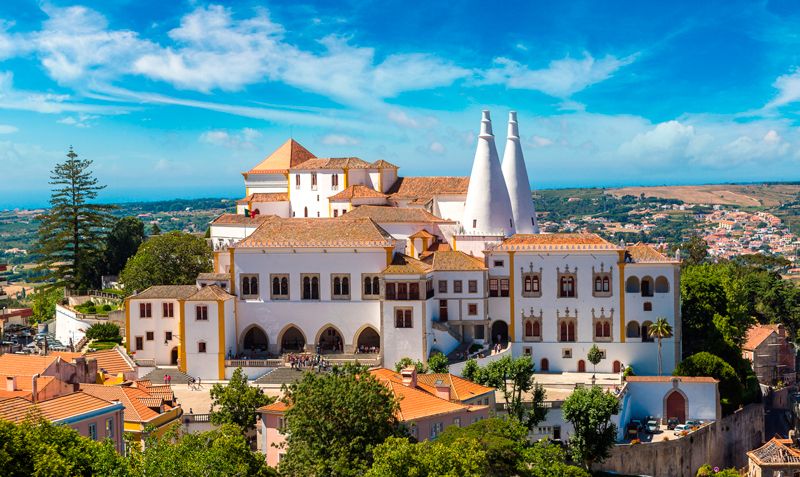
Sintra National Palace is the best-preserved medieval royal residence in Portugal. Despite inhabitated more or less continuously from at least the early 15th century to late 19th century. It is a significant tourist attraction, and is part of the cultural landscape of Sintra, a designated UNESCO World Heritage site.
Of all the palaces built by the Portuguese monarchs throughout the Middle Ages, only the palace of Sintra has survived to the present day virtually intact.
Located downhill from the Castelo dos Mouros, was the residence of the Islamic Moorish Taifa of Lisbon. In the 12th century, King Afonso Henriques conquered the village, and took the ‘Sintra Palace’ castle for his use. The blend of Gothic, Manueline, Moorish, and Mudéjar styles in the present palace is, however, mainly the result of building campaigns in the 15th and early 16th centuries.
Nothing built during Moorish rule or during the reign of the first Portuguese kings survived.
King Dinis (reigned, 1279-1325) was probably the first king to become interested in the Sintra Palace. His quarters was at the highest point of the building, to the north, next to the Palatine Chapel. This chapel still survives today and is one of the oldest parts of the palace. It has since become known as the Bedroom-Prison of King Afonso VI.
Much of the palace dates from the times of King João I, who sponsored a major building campaign starting around 1415. Most buildings around the central courtyard – called the Ala Joanina – date from this campaign, including the main building of the façade with the entrance arches and the mullioned windows in Manueline and Moorish styles, and many other places.
Opening Times 2018/2019
09:30 – 19:00, last ticket and last admission 18:30
Prices 2018/2019
Adults (18 – 64 yrs) – 10€
Youths (6 – 17 yrs) – 8,5€
Seniors (over 65 yrs) – 8,5€
Family ticket (2 adults + 2 youths) – 33€
Queluz National Palace (Palácio de Queluz)
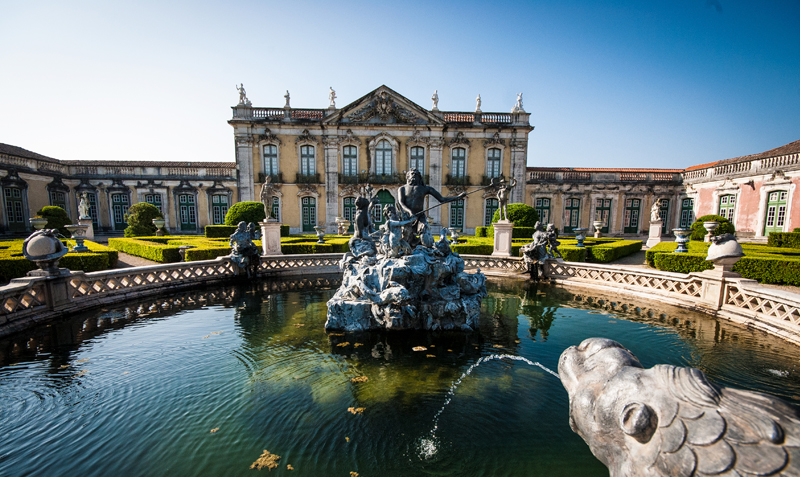
The Palace of Queluz is a Portuguese 18th-century palace located at Queluz, a city of Sintra’s Municipality. Close to both Sintra and Lisbon, the National Palace of Queluz and its historical gardens are one of the most remarkable examples of the harmonious link between landscape and palatial architecture in Portugal.
Conceived as a summer retreat for Dom Pedro of Braganza, later to become husband and then king consort to his own niece, Queen Maria I. It served as a discreet place of incarceration for Queen Maria as her descent into madness continued in the years following Dom Pedro’s death in 1786. After the destruction of the Ajuda Palace in 1794, Queluz Palace became the official residence of the royal family until they fled to the Portuguese colony of Brazil in 1807 following the French invasion of Portugal.
Portuguese architect Mateus Vicente de Oliveira began works on the palace in 1747. Even thought is far smaller, the palace is known as the Portuguese Versailles.
In 1908, it became the property of the state. Today is open to the public as a major tourist attraction.
One wing of the palace, is now a guest house for foreign heads of state visiting Portugal.
Opening times 2018/2019
PALACE AND GARDENS
9:00 – 19:00, last ticket and last admission 18:00
Prices 2018/2019
PALACE AND GARDENS Tickets
Adults (18 – 64 yrs) – 10€
Youths (6 – 17 yrs) – 8,5€
Seniors (over 65 yrs) – 8,5€
Family ticket (2 adults + 2 youths) – 33€
GARDENS Tickets
Adults (18 – 64 yrs) – 5€
Youths (6 – 17 yrs) – 3,5€
Seniors (over 65 yrs) – 3,5€
Family ticket (2 adults + 2 youths) – 15€
Best way to visit Sintra?
You can join us on a private day tour to Sintra & Cascais or personalizing your own tour! Give us a call or send us an e-mail, we’ll be glad to hear from you!

